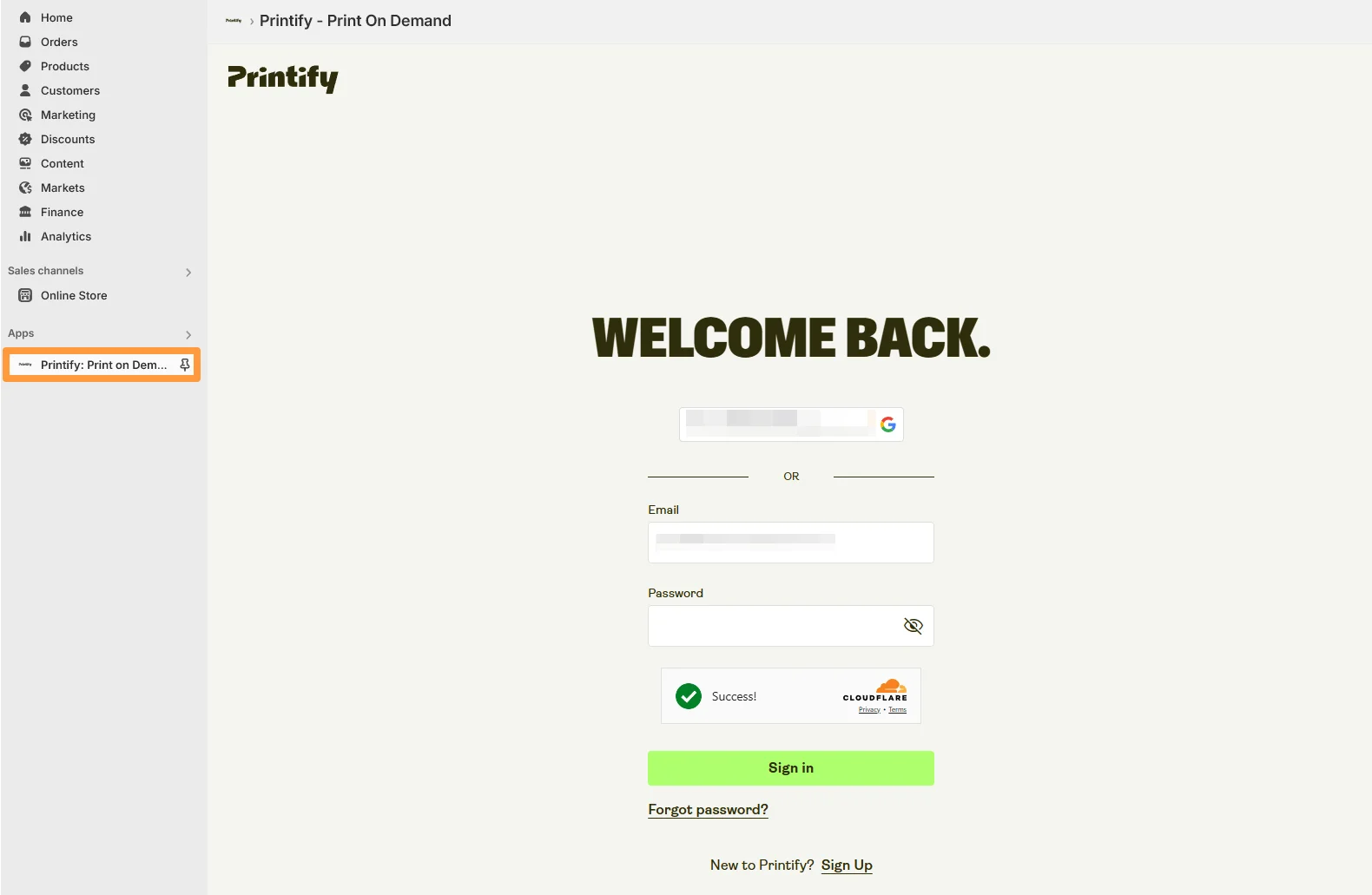Choosing the right tools for your online business can be difficult, especially when comparing options like Shopify vs Printify. Both platforms serve different purposes, but they are often used together to create a smooth print-on-demand experience.
Because they offer different functions, many people wonder how Printify vs Shopify truly compare. Understanding your inquiry, LitExtension – The #1 eCommerce Migration Expert has created this article to help you break down each platform, based on these criteria:
- Build an online store
- Sourcing products
- Inventory management
- Shipping and fulfillment
- Mobile app
- Ease of use
- Pricing
By the end, you’ll know exactly which platform suits your business needs, or whether using both is the smartest move. Let's get started!
Shopify vs Printify – Our Quick Verdict
Although users often compare Shopify and Printify as if they’re alternatives, the truth is they serve very different purposes. Shopify is a powerful eCommerce platform for building and managing an online store, while Printify is a print-on-demand service that fulfills and ships custom products. That said, they can be used together seamlessly, especially if you're launching a print-on-demand business.
Below is a quick Shopify vs Printify comparison to help you compare both solutions in detail:
Shopify | Printify | |
Main Use | Build, run, and scale your own branded online store | Create and sell custom products via print-on-demand fulfillment |
Target Users | Entrepreneurs, brands, and businesses building a full online store | Designers, artists, or small sellers wanting to sell custom merchandise |
Core Functions | Website builder, product management, payment processing, integrations | Product mockups, printing, automatic order fulfillment, integration support |
Build Online Store | Full-featured website builder with themes and checkout | No standalone website; syncs with platforms like Shopify, Etsy |
Inventory Management | Manual or app-based inventory tracking and syncing | No inventory required (products made on demand) |
Shipping & Fulfillment | Depends on third-party apps or fulfillment partners | Handled by Printify’s global print provider network |
Mobile App | Full Shopify admin app with order and store management | Printify app for managing product creation and orders |
Store Design | Highly customizable themes and drag-and-drop editor | Simple and minimal storefront design to sell on social media |
Ease of Use | Moderate learning curve, more setup needed | Beginner-friendly for product setup and order tracking |
Customer Support | Support via email, help center, and community | Support via live chat, email, and help center |
So, who is Shopify and Printify for? Here are our quick verdicts:
- Use Shopify if you want to build your own branded online store with full control over design, payments, and customer experience.
- Use Printify if you want to easily create and sell custom products without dealing with inventory, printing, or shipping.
- Or, integrate Printify with Shopify if you're starting a print-on-demand business and want a scalable, automated setup. Then, you can use Printify for fulfillment and Shopify to power your store.
Main Printify vs Shopify Difference You Should Know About
The biggest difference between Shopify and Printify lies in their core purpose. Shopify is an eCommerce platform that helps you build, design, and manage your online store, while Printify is a print-on-demand (POD) service that takes care of product creation, printing, and fulfillment.
In simple terms, Shopify gives you the storefront, and Printify provides the products and fulfillment. Shopify provides a full set of Shopify features that allow you to build a fully functional eCommerce website where customers can browse, buy, and pay for products. You can sell anything, from digital items to physical goods, depending on your business model.

Printify, on the other hand, does not host a store or process payments directly. Instead, it lets you create custom-printed products such as t-shirts, mugs, or posters. Once a customer places an order, Printify automatically sends it to one of its print providers, who handle production and shipping under your brand name.
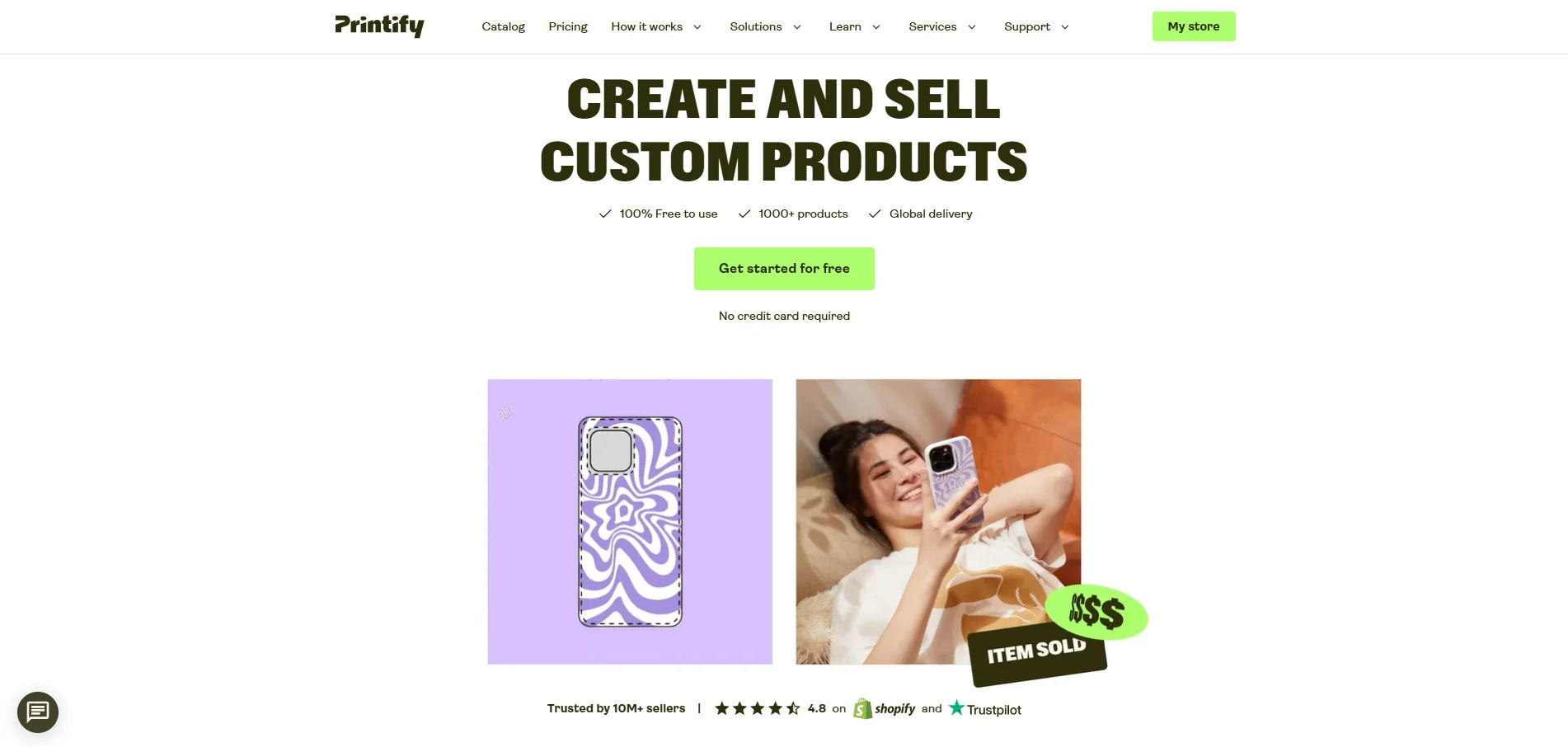
The key takeaway is that Shopify focuses on selling, while Printify focuses on fulfillment. They serve different roles in the eCommerce ecosystem, but can work perfectly together. By integrating Printify with Shopify, you can manage everything in one place: Shopify handles your storefront, and Printify fulfills your orders automatically. This setup is ideal for entrepreneurs who want to start selling custom products on a branded storefront without managing inventory or logistics.
The Similarities Between Shopify vs Printify
Even though Shopify and Printify serve different purposes, they share several similarities that make them work well together in the eCommerce ecosystem. Both platforms are designed to simplify online selling, reduce manual work, and help you grow your business efficiently.
In this section, we'll explore all the differences between Shopify vs Printify in key areas.
Build an online store
The verdict:
If your goal is to build a branded, customizable, and scalable online store, Shopify has the clear edge in the Shopify vs Printify comparison. It gives you everything you need to create a robust digital storefront and grow your business.
On the other hand, Printify’s Pop-Up Store is useful for simple, low-commitment selling, ideal for side projects, test launches, or creators just getting started.
Shopify is built specifically for eCommerce. It offers a comprehensive set of tools that allow you to create a professional online store with little to no coding. You can choose from a wide range of Shopify themes, both free and paid, designed for various industries. Each theme is responsive by default, meaning your store will look great on mobile, tablet, and desktop.
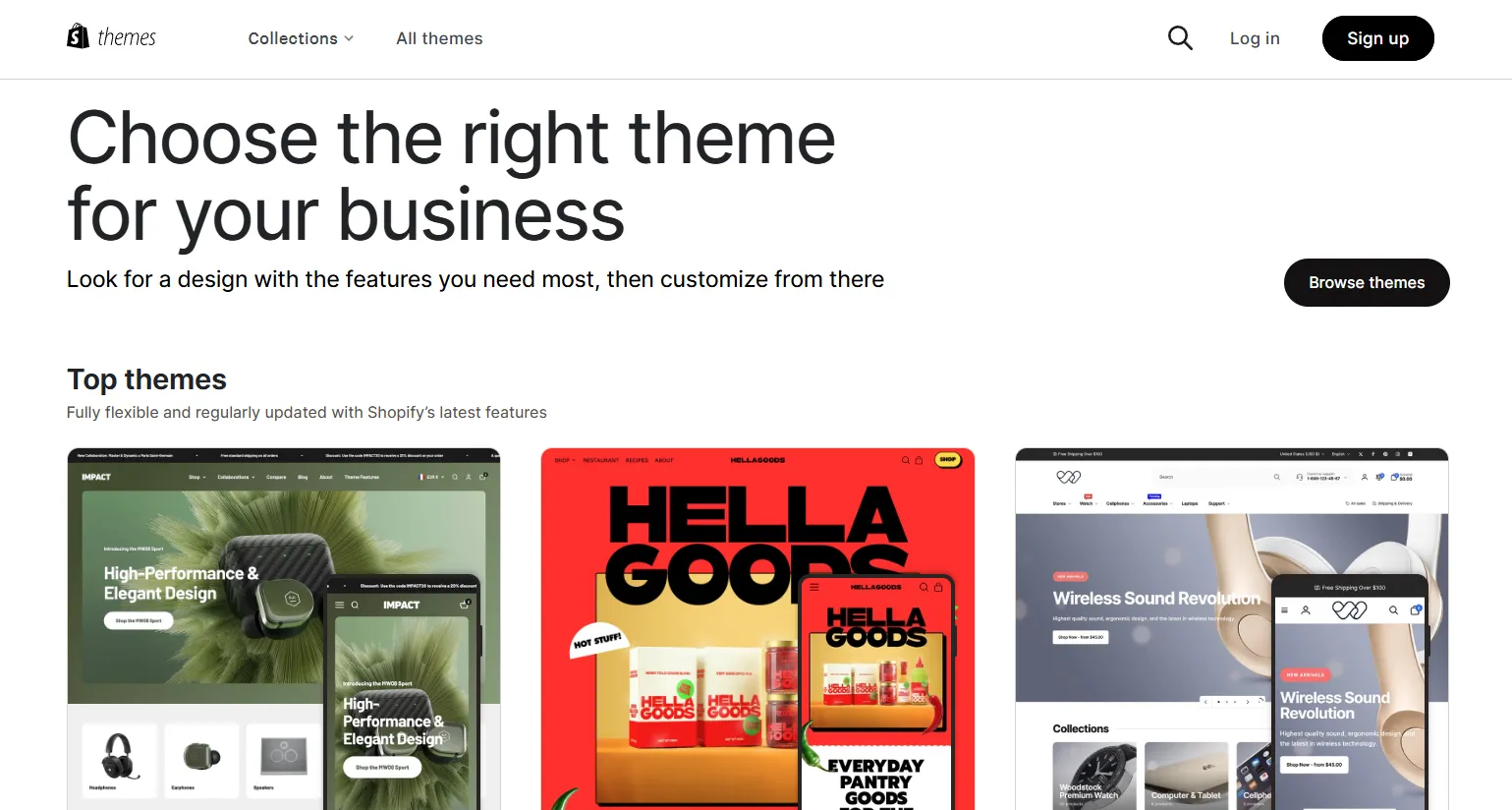
Additionally, customization is made simple with Shopify’s built-in drag-and-drop editor. You can modify the homepage layout, rearrange sections, add promotional banners, and change fonts or colors to match your brand. Beyond the design, Shopify also allows you to create and manage product collections, set up discount codes, manage SEO settings, and create content-rich pages like “About Us,” “Contact,” and blog posts.
Unlike Shopify, Printify is not an eCommerce platform and does not provide a traditional website builder. Instead, it focuses on print-on-demand services, allowing you to create custom products and connect them to your preferred selling platform like Shopify, Etsy, or Wix. However, for users who don’t yet have a store or want to test product ideas, Printify offers a feature called the Printify Pop-Up Store.
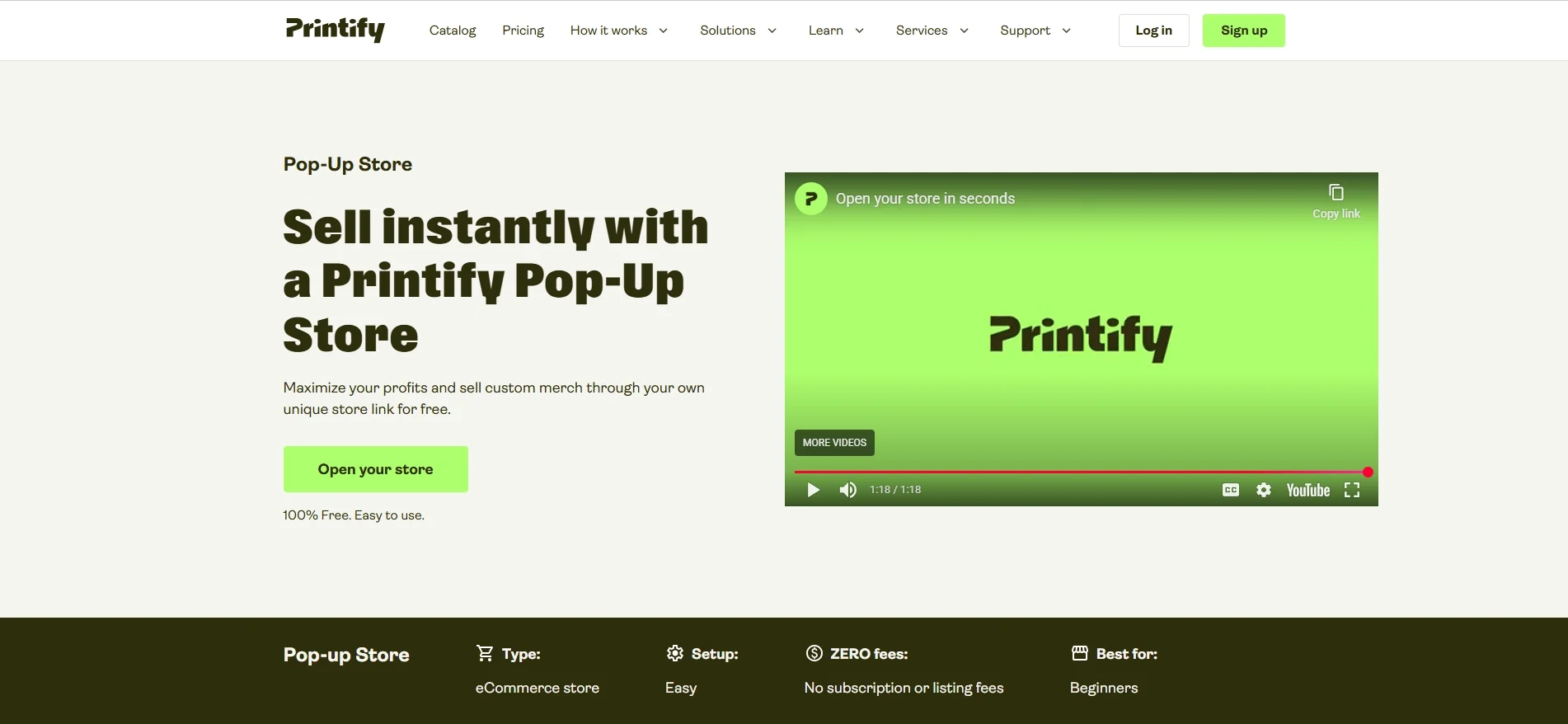
The Pop-Up Store is a simple, one-page storefront hosted by Printify. It allows you to showcase your custom-designed products and sell directly through a unique link. Setup is quick, you select which products to include, and Printify handles the checkout and payment processing through Printify Payments. This eliminates the need to connect a third-party platform or deal with any web development.
That said, the Pop-Up Store is minimal. It does not offer multi-page navigation, advanced layout customization, SEO tools, or support for blogging and marketing features. Additionally, you also cannot use your own domain name, which is a huge disadvantage for those who want to create a fully branded online presence.
Sourcing products
The verdict:
The comparison between Shopify vs Printify comes down to control versus convenience. Shopify gives you the tools to source products from anywhere, but puts the responsibility on you to manage the process. Meanwhile, Printify simplifies sourcing by offering ready-to-sell, print-on-demand products with zero inventory risk.
If you want to sell custom products with minimal hassle, Printify is the better choice. But if you want a wide-open product strategy, Shopify gives you the flexibility to build it your way.
Shopify serves as a flexible platform that supports many sourcing methods but does not supply products directly. To stock your store, you can:
- Create and sell your own physical or digital products.
- Partner with dropshipping apps like DSers or Spocket.
- Work with third-party suppliers or wholesale providers.
This flexibility gives Shopify users full control over their product selection and pricing. However, it also means extra responsibility; managing suppliers, inventory, and fulfillment logistics is entirely up to you unless you use apps that automate parts of the process.
In contrast, Printify simplifies product sourcing by offering a large catalog of customizable, print-on-demand products. These include apparel, mugs, posters, phone cases, home decor, and more. Once you design a product using Printify’s mockup generator, it’s automatically routed to a print provider who handles production and shipping after each order.
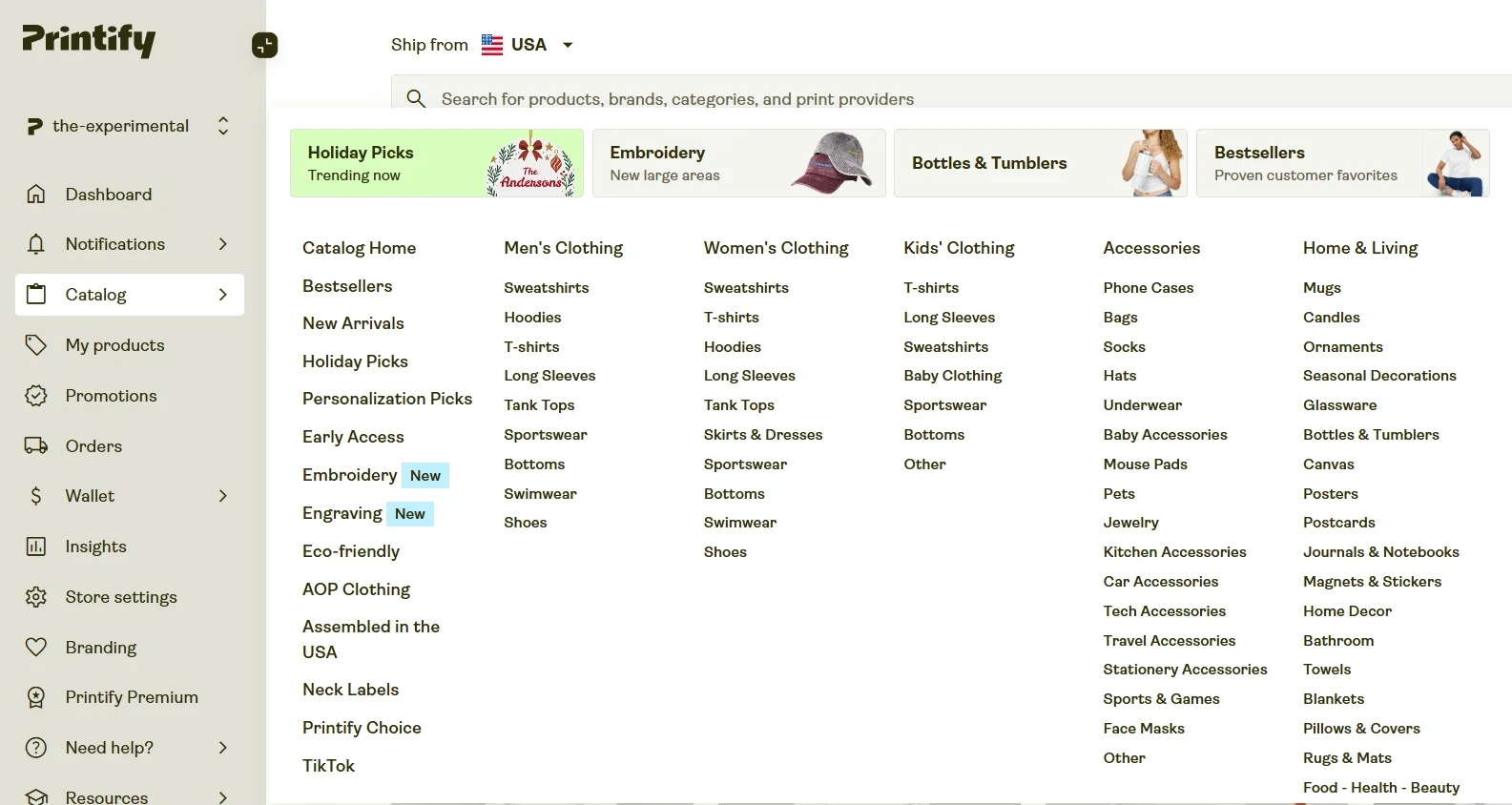
In the Shopify vs Printify comparison, this is where Printify shines: it removes the need to hold inventory, invest upfront in products, or worry about shipping. All you need to do is focus on design and marketing while Printify handles the rest.
Inventory management
The verdict:
In the Shopify vs Printify comparison, inventory management is one of the areas where their fundamental differences are most evident. Shopify is built to handle physical inventory and gives you full control over how it's tracked and managed.
Printify, on the other hand, operates on a print-on-demand model, meaning you don’t manage inventory at all because products are only created after a customer places an order.
Shopify is designed for merchants who sell physical products, whether they keep inventory in a warehouse, in-store, or at home. It offers a built-in Shopify inventory system that allows you to monitor stock levels for every product and variant in your store. You can set inventory policies, such as allowing backorders or preventing purchases when stock reaches zero. Shopify also supports multiple inventory locations, which is useful if you fulfill orders from several warehouses or retail stores.
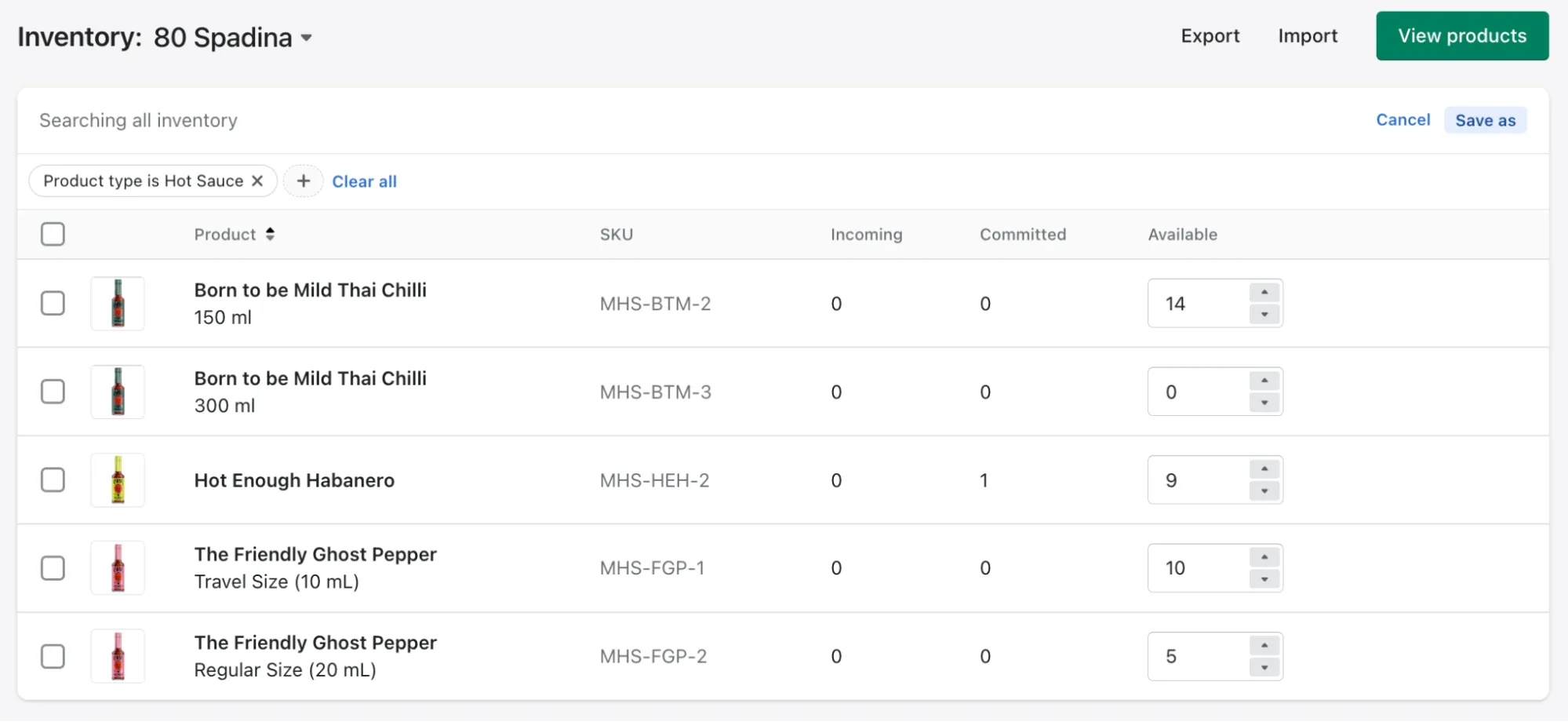
Beyond the core features, Shopify integrates with a wide range of inventory management apps that offer advanced capabilities like demand forecasting, barcode scanning, purchase order creation, and automated restocking. For growing businesses or brands managing large product catalogs, these tools are essential for preventing overselling, optimizing stock levels, and ensuring smooth fulfillment operations.
Unlike Shopify, Printify eliminates the need to manage inventory entirely. As a print-on-demand platform, Printify only produces products after a customer places an order. This means you don’t have to purchase stock upfront, store it, or track how much of it you have. Every item you list in your store is essentially a product blueprint, ready to be printed, packaged, and shipped by one of Printify’s print partners when a sale comes in.
This model significantly lowers the risk for new sellers because it removes the need for inventory investment and storage. You never have to worry about overstock, dead stock, or running out of inventory. Additionally, you can switch between different print providers based on location, price, or product quality without dealing with leftover stock.
Shipping and fulfillment
The verdict:
When comparing Shopify vs Printify, both platforms handle shipping and fulfillment very differently, primarily due to their roles in the selling process. Shopify gives you full control over how you fulfill orders, whether you handle it yourself, work with a third-party logistics (3PL) provider, or use dropshipping and print-on-demand apps.
Printify, in contrast, automates the entire fulfillment process by routing each order to a print provider who handles printing, packing, and shipping, making it ideal for sellers who want a hands-off setup.
With Shopify, you're in full control of your fulfillment strategy. This platform offers built-in tools to manage these processes, including real-time shipping rate calculations, shipping label generation, order tracking, and delivery notifications. You can set up shipping zones, apply shipping rules based on weight or price, and offer free shipping or local pickup.
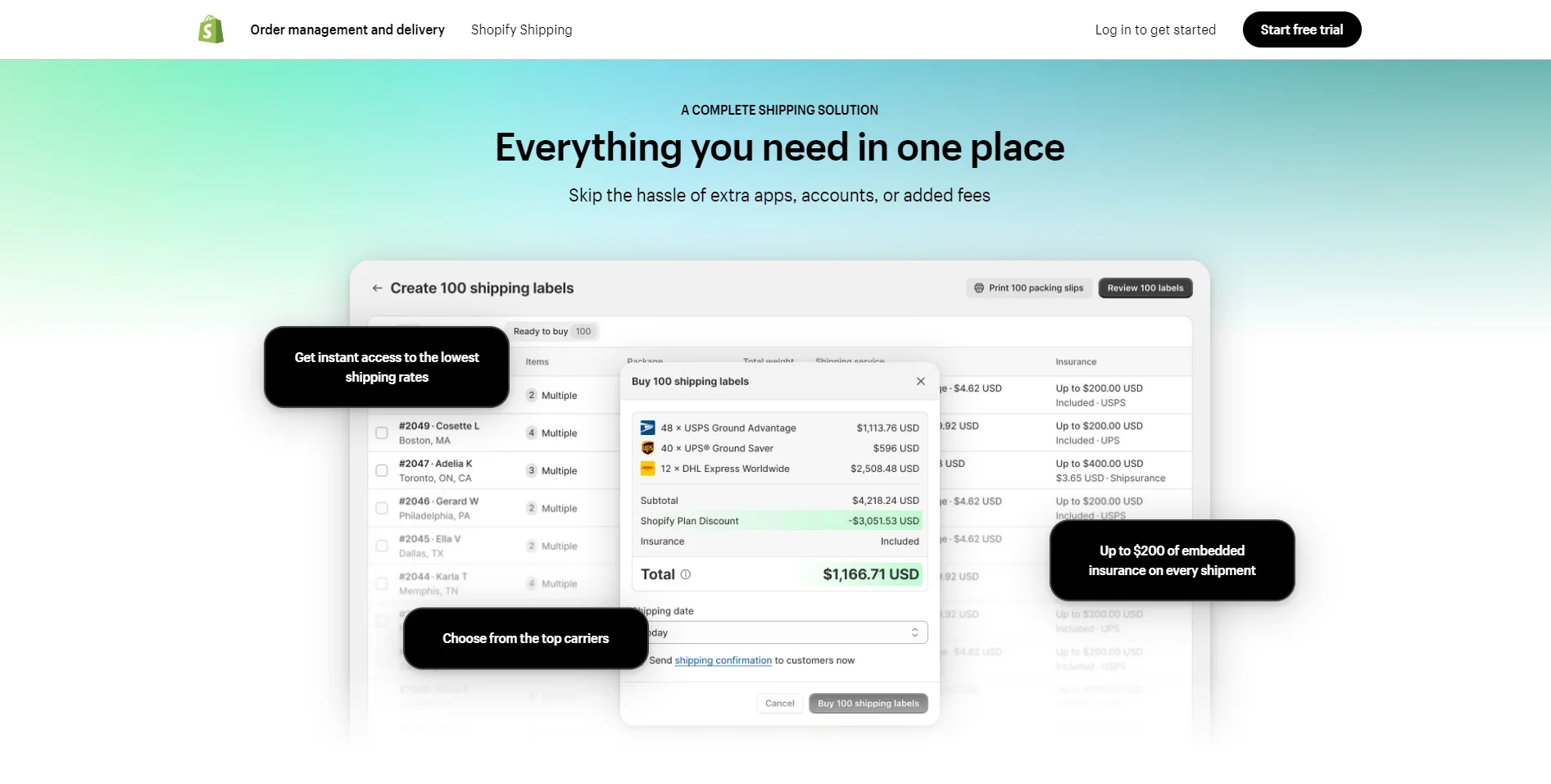
Shopify also supports custom packaging and branding, which is especially useful for businesses looking to create a consistent brand experience. Additionally, Shopify integrates with major carriers like USPS, UPS, DHL, and Canada Post, and lets you access discounted rates depending on your plan and location.
Meanwhile, Shopify simplifies the entire shipping and fulfillment process by automatically sending orders to the selected print provider once a customer purchases a product. Each provider handles everything, from printing and packing to shipping, based on the delivery preferences set in your Printify account.
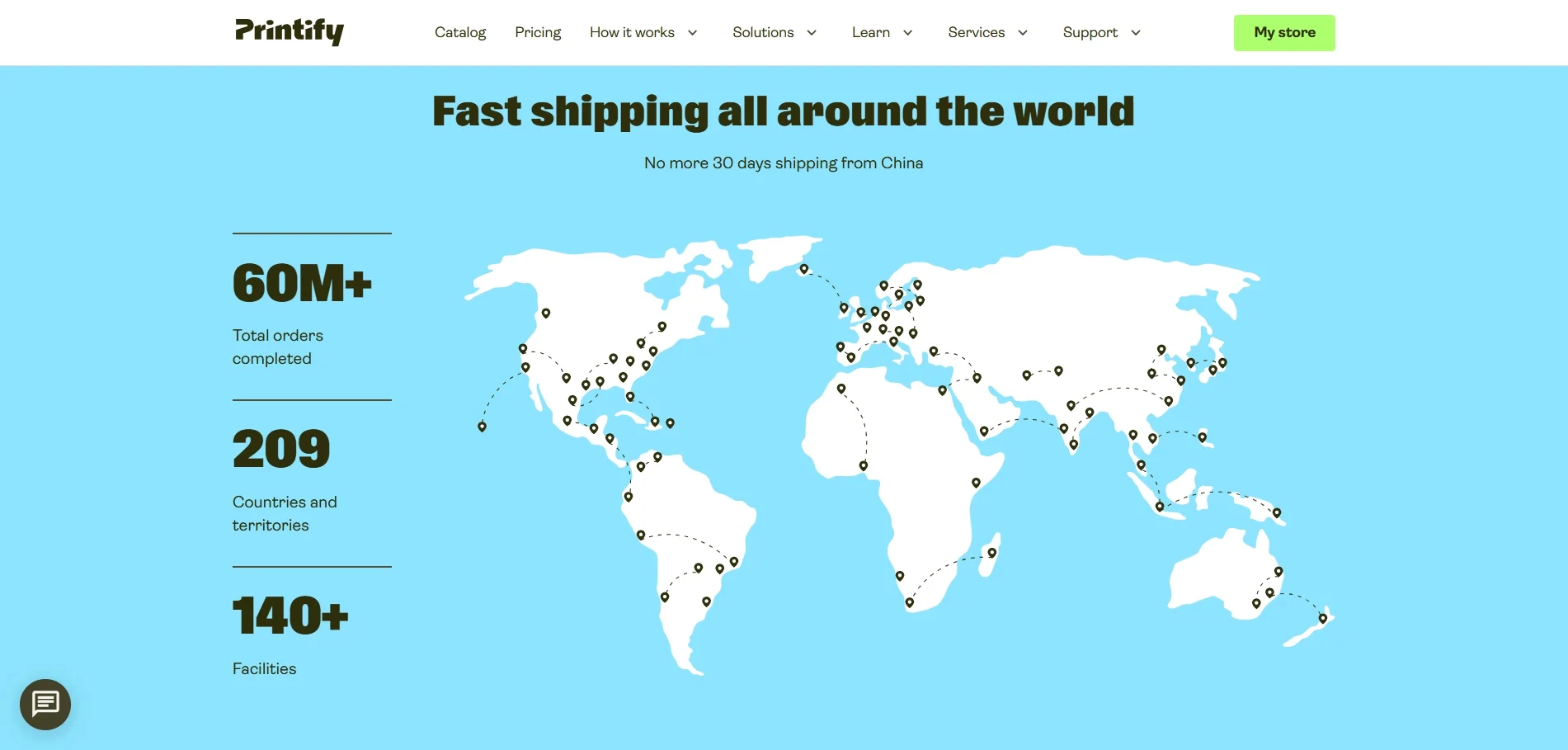
Shipping through Printify is based on your selected print provider’s location and shipping methods. Each product listing within Printify includes detailed information on shipping costs, estimated delivery times, and available destinations. However, since you don’t control the shipping carrier directly, customization and delivery speed may vary depending on the provider. Still, the automation and low overhead make it a preferred option for print-on-demand sellers.
Mobile app
The verdict:
In the Shopify vs Printify comparison, both platforms offer mobile apps, but with different strengths. Shopify provides a powerful mobile app designed to manage your entire store, while Printify now offers a mobile app focused on helping you stay in control of your print-on-demand orders from anywhere.
Shopify's mobile app is built to give you full control over your online store, wherever you are. Available for both iOS and Android, the Shopify app lets you manage products, track orders, update inventory, view analytics, communicate with customers, and even process refunds, all from your phone or tablet. You can also edit product details, create discount codes, manage marketing campaigns, and access your store’s dashboard with real-time data.
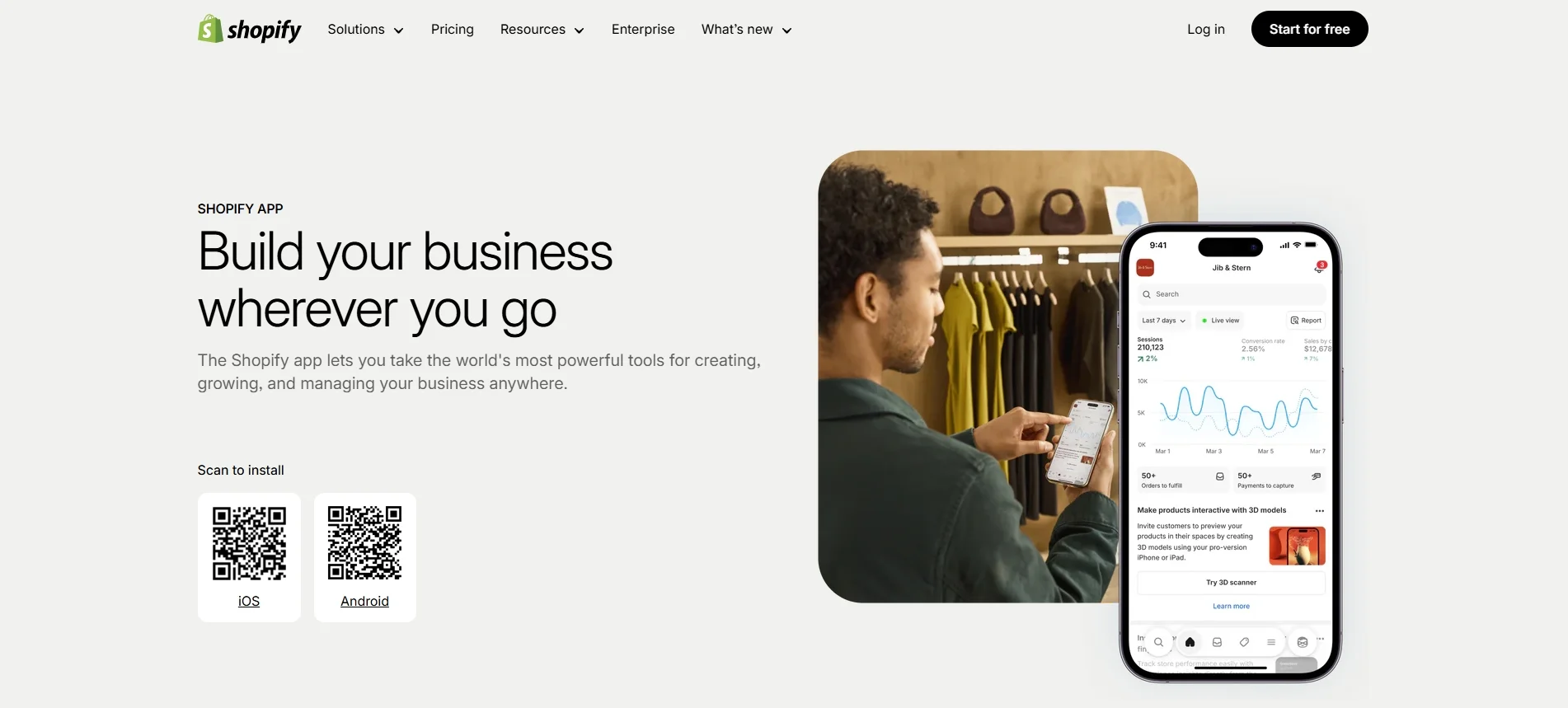
For store owners running a busy business, the Shopify mobile app acts as a complete command center, allowing you to stay connected and respond quickly to store activity without needing a desktop.
Printify, meanwhile, has recently released its own mobile app tailored for print-on-demand sellers. While not as comprehensive as Shopify’s, the Printify app helps you stay connected to your fulfillment workflow. With the app, you can view all your orders in one place, update order details before submission, track production and fulfillment progress, and receive real-time updates.

Whether you're just starting out or running a high-volume POD store, the app offers a simple way to manage your backend from your phone.
Ease of use
The verdict:
When it comes to ease of use between Shopify vs Printify, both platforms are designed to simplify the eCommerce experience, but they approach ease of use in different ways.
Shopify is a robust platform with a wide range of features, which means it has a slightly steeper learning curve, especially for beginners building their first online store. Printify, on the other hand, is highly beginner-friendly and focuses on making product creation and fulfillment as straightforward as possible.
Getting started with Shopify involves more setup steps. You’ll need to choose a theme, customize your store layout, add products, configure payment and shipping settings, and possibly install third-party apps for added functionality. While Shopify does provide helpful onboarding guides and an intuitive dashboard, the platform’s flexibility means there are more decisions to make and tools to learn.

For those who want full control over their store and are willing to invest a bit of time up front, Shopify offers a powerful and scalable solution.
Printify offers a much simpler experience from the moment you sign up. The platform is designed specifically for print-on-demand sellers, so it walks you through the process of selecting a product, uploading your design, choosing a print provider, and publishing the item to your store. The interface is clean, easy to navigate, and focused only on what’s necessary for product creation and fulfillment.
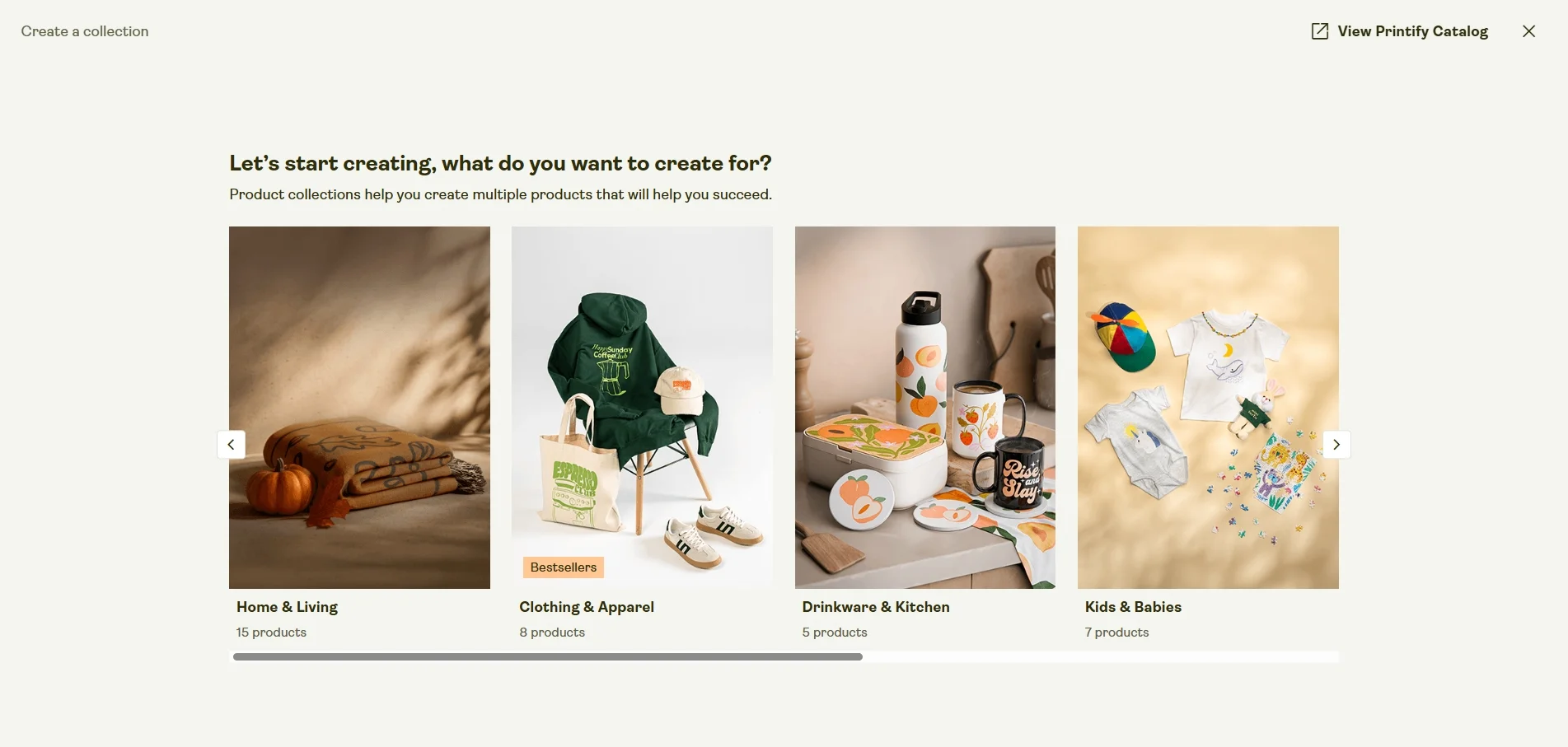
Even users with no prior eCommerce experience can get their first product live within minutes. In the Shopify vs Printify context, Printify clearly wins for ease of onboarding and day-to-day simplicity.
Pricing
Shopify vs Printify pricing reflects the different roles these platforms play in your eCommerce business. Shopify is a full-scale online store builder, so its pricing is based on access to features, store infrastructure, and scalability. Printify, on the other hand, is a print-on-demand service provider, and its pricing focuses on access to fulfillment tools and discounts on products.
Shopify’s pricing is designed to support businesses of all sizes, from new entrepreneurs to large enterprises. Each plan unlocks more advanced features, higher staff limits, and better shipping discounts.
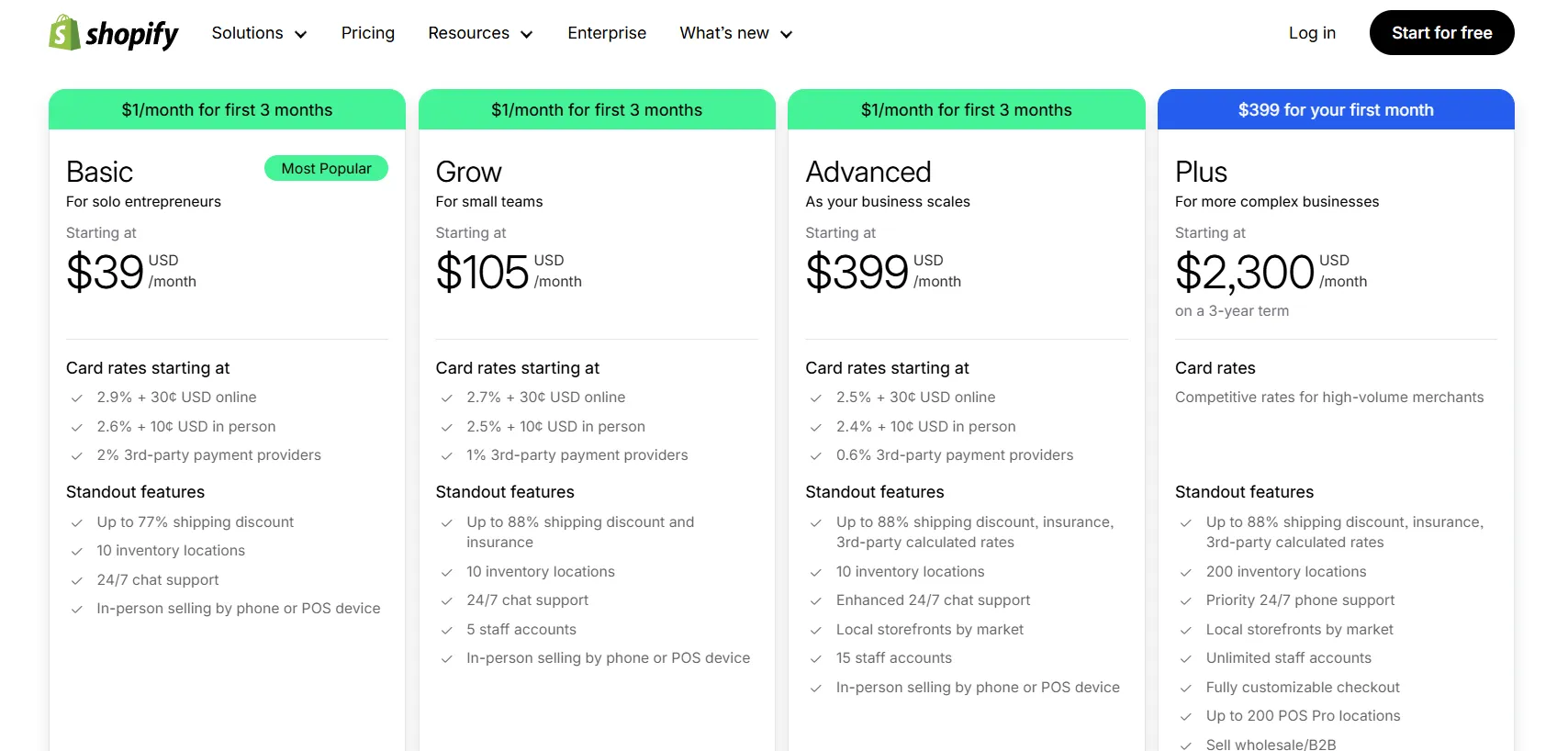
- Basic ($39/month): Ideal for solo entrepreneurs. Includes up to 10 inventory locations, 24/7 chat support, in-person selling options, and up to 77% shipping discounts.
- Grow ($105/month): Suited for small teams. Offers up to 5 staff accounts, 10 inventory locations, enhanced shipping discounts (up to 88%), and additional analytics tools.
- Advanced ($399/month): Best for scaling businesses. Adds 15 staff accounts, advanced shipping rate calculations, local storefront support, and priority customer service.
- Shopify Plus (from $2,300/month): Tailored for high-volume enterprises. Includes unlimited staff accounts, a fully customizable checkout, up to 200 POS Pro locations, and support for wholesale/B2B selling.
All plans include powerful eCommerce features, access to the Shopify App Store, and discounted rates when paid annually. New users can also try Shopify for just $1/month for the first 3 months, making it easier to test the platform before fully committing.
Printify, on the other hand, offers a free plan for beginners, which includes access to unlimited product designs and up to 5 connected stores per account. This is ideal for new sellers or those testing product ideas.
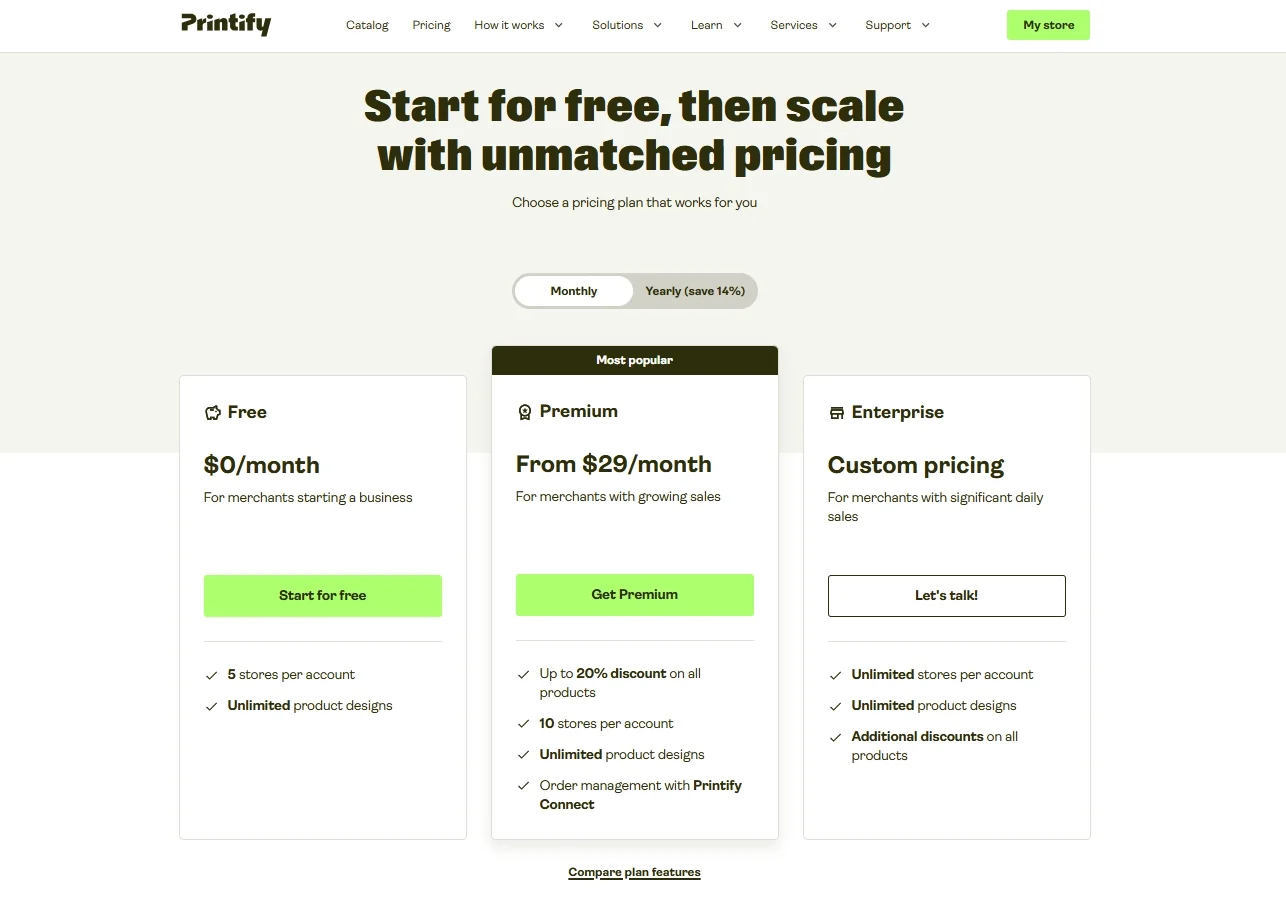
For more serious sellers, the Premium plan costs $29/month and offers up to 20% discounts on all products, access to 10 stores per account, and additional features like order management through Printify Connect. For high-volume businesses, the Enterprise plan uses custom pricing and includes unlimited stores, unlimited product designs, and extra discounts across the entire product catalog. All plans support Printify's core features, including automatic order routing and integration with platforms like Shopify.
Using Printify with Shopify: Is It Possible?
Yes, using Printify with Shopify is not only possible, it’s one of the most popular and effective ways to run a print-on-demand business. Printify integrates seamlessly with Shopify, allowing you to design products in Printify and automatically sync them to your Shopify store. When a customer places an order on your Shopify site, Printify takes over fulfillment by sending the order to a print provider who handles production and shipping.
Here's how you can sell dropshipping or print-on-demand with Printify on your Shopify store:
- Step 1. From your Shopify admin dashboard, navigate to Apps and search for Printify on the Shopify App Store.
- Step 2. Click the “Install” button. You'll then be directed back to your admin dashboard with the new app already there.
- Step 3. If this is your first time using Printify, sign up with your email address. In case you're already a member, simply log in using your registered account.
This setup is ideal for sellers who want to focus on product design and marketing without worrying about inventory or logistics. By combining Shopify’s storefront capabilities with Printify’s print-on-demand network, you get a complete, automated eCommerce solution. It’s a flexible, low-risk way to launch and scale a dropshipping business, especially if you’re just getting started.
Our Methodology: How We Test Shopify vs Printify
To provide an honest and complete comparison of Shopify vs Printify, we follow a structured evaluation process. This ensures our insights are accurate, practical, and useful for business owners. Below, we explain each step of our testing approach in detail.
1. Hands-on platform testing
Our team creates test accounts on both Shopify and Printify to explore every key feature firsthand. We build sample stores, connect integrations, and test print-on-demand workflows from product creation to order fulfillment. This hands-on approach allows us to understand how each platform performs in real-world situations rather than relying on theory or marketing claims.
2. Feature and functionality evaluation
We examine each platform’s main functions based on business needs. For Shopify, we focus on store design, product management, checkout, and app integrations. For Printify, we test catalog variety, supplier reliability, and order automation. We also check how well Printify integrates with Shopify to ensure a seamless selling experience.
3. Ease of use assessment
We assess how easy it is for beginners and small business owners to start using each platform. This includes setup time, dashboard navigation, clarity of instructions, and learning curve. Our goal is to determine which platform offers a smoother experience for users without technical skills.
4. Pricing and value for money
We carefully compare pricing plans, hidden fees, and extra costs like apps or transaction charges. We also calculate potential profits for a small print-on-demand business running on Shopify with Printify integration. This helps readers understand the real value each platform delivers for the price they pay.
5. Support and documentation review
We reach out to customer support teams on both platforms to test response time, quality of help, and availability across channels. We also explore community forums and knowledge bases to check how easy it is to find self-help resources when issues arise.
6. Security and reliability testing
Since trust and data protection are vital for any online store, we review each platform’s security features. We check for SSL encryption, PCI compliance, and privacy policies. For Printify, we also verify how secure their supplier network and order tracking systems are.
By following this detailed process, we ensure that our Shopify vs Printify comparison reflects practical performance, not just surface-level features. Each section of this article is based on verified results from our testing, helping you make a confident and informed decision.
Shopify vs Printify – FAQs
Which one is better, Shopify or Printify?
It depends on your needs. Shopify is a full eCommerce platform that lets you build and manage an online store, while Printify is a print-on-demand service that handles product creation and fulfillment. They’re not direct alternatives, in fact, many sellers use them together.
What are the downsides of Printify?
While Printify is easy to use and offers a large product catalog, it does have a few limitations. Its storefront customization options are quite limited. Shipping times and quality can also vary depending on the print provider you choose, and branding options are limited compared to handling fulfillment yourself.
Can I use Printify to sell on Shopify?
Yes, Printify integrates directly with Shopify. Once connected, you can publish Printify products to your Shopify store, and orders placed through Shopify will automatically be fulfilled by Printify’s print providers. It’s a popular and effective setup for running a print-on-demand business.
Is Shopify good for print-on-demand products?
Absolutely. Shopify supports a wide range of print-on-demand apps, including Printify. It gives you full control over your storefront, branding, pricing, and customer experience, while letting Printify handle fulfillment behind the scenes. This makes Shopify an excellent choice for anyone building a print-on-demand business.
Final Words
When comparing Shopify vs Printify, it’s clear that these two platforms serve very different but highly complementary roles in the eCommerce world. Shopify gives you the tools to build, customize, and grow a full-featured online store, while Printify simplifies product creation and fulfillment through its print-on-demand network.
By combining both, you get the freedom to focus on marketing, branding, and customer experience, without worrying about inventory or logistics. Whether you’re just getting started or looking to scale, Shopify and Printify together offer a powerful, low-risk way to run your eCommerce business.
For additional information on the eCommerce industry, please don't forget to check out other articles on our LitExtension blog.

